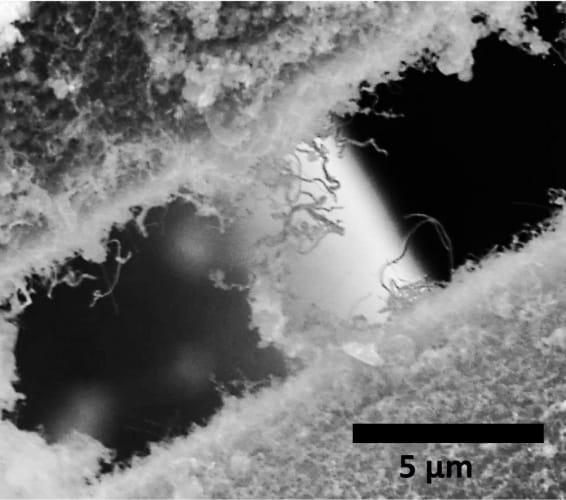SiC nanotubes help strengthen rocket engines
Silicon carbide nanotubes have been found to add strength to the ceramic composite materials NASA is using for its next generation of rocket engines.


(Ajayan Research Group/Rice University)
Developed by researchers at Rice University, the nanotubes have loops and curls on their exposed surfaces. Acting like Velcro, the nanomaterials hook into the surface of the ceramic materials NASA is deploying on its latest engines. The silicon carbide nanotubes strengthen the composite materials beneath and also prevent exposure to oxygen which can cause cracking.
The research, described in the American Chemical Society journal Applied Materials and Interfaces, was a collaboration between Rice graduate Amelia Hart, Rice postdoctoral associate Chandra Sekhar Tiwary, plus NASA research engineer Janet Hurst.
"[Hurst] was partially converting silicon carbide from carbon nanotubes," Hart explained. "We used her formulation and my ability to grow nanotubes and figured out how to make the new composite."
The Rice team grew the nanomaterials by first bathing silicon carbide fibre in an iron catalyst and then using water-assisted chemical vapour deposition to embed a carpet of carbon nanotubes directly into the surface. The fibres were then heated in silicon nanopowder at high temperature, converting the carbon nanotubes into a silicon carbide "fuzz”. The researchers believe this “fuzz” will help NASA’s ceramic composites withstand higher temperatures than normal.
Register now to continue reading
Thanks for visiting The Engineer. You’ve now reached your monthly limit of news stories. Register for free to unlock unlimited access to all of our news coverage, as well as premium content including opinion, in-depth features and special reports.
Benefits of registering
-
In-depth insights and coverage of key emerging trends
-
Unrestricted access to special reports throughout the year
-
Daily technology news delivered straight to your inbox











Water Sector Talent Exodus Could Cripple The Sector
Maybe if things are essential for the running of a country and we want to pay a fair price we should be running these utilities on a not for profit...